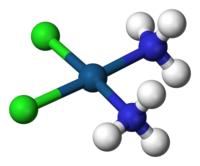
Photo from wikipedia
Copper is an essential element in nature but in excess, it is toxic to the living cell. The human metallochaperone Atox1 participates in copper homeostasis and is responsible for copper… Click to show full abstract
Copper is an essential element in nature but in excess, it is toxic to the living cell. The human metallochaperone Atox1 participates in copper homeostasis and is responsible for copper transmission. In a previous multiscale simulation study, we noticed a change in the coordination state of the Cu(I) ion, from 4 bound cysteine residues to 3, in agreement with earlier studies. Here, we perform and analyze classical molecular dynamic simulations of various coordination states: 2, 3, and 4. The main observation is an increase in protein flexibility as a result of a decrease in the coordination state. In addition, we identified several populated conformations that correlate well with double electron–electron resonance distance distributions or an X‐ray structure of Cu(I)‐bound Atox1. We suggest that the increased flexibility might benefit the process of ion transmission between interacting proteins. Further experiments can scrutinize this hypothesis and shed additional light on the mechanism of action of Atox1.
Journal Title: Protein Science
Year Published: 2022
Link to full text (if available)
Share on Social Media: Sign Up to like & get
recommendations!